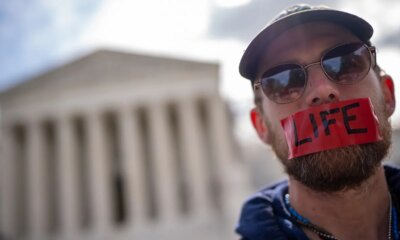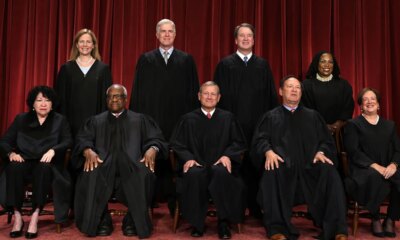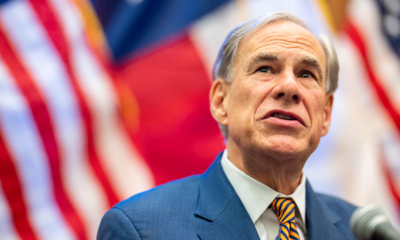News
Chief Justice Roberts’s Two Landmark Opinions Turn Tide Toward Liberty

UNITED STATES – JANUARY 30: Supreme Court Chief Justice John Roberts listens to President Donald … [+]
Just in time for America’s 248th birthday, Chief Justice John Roberts has gifted our nation two landmark decisions that turn the tables on unlawful administrative power and turn the tide toward liberty. These cases do more to save Americans from being dominated by bureaucratic overlords than anything else the Court has done in at least half a century. The decisions in Securities and Exchange Commission v. Jarkesy and Loper Bright v. Raimondo (decided alongside NCLA’s case Relentless v. Department of Commerce) do not just right two wrongs; they deliver a one-two punch for independence. In different ways, each case changes the direction in which our ship of state was headed and steers it back on a course that is far more compatible with individual liberty and self-government than the tyrannical trajectory onto which the Court veered a century ago. Together they establish a legacy for The Chief Justice of the United States as a loyal defender of the structural Constitution and an ardent foe of unlawful administrative power.
A fuller examination of these two opinions will reveal just how rejuvenating they are. As Chief Justice Roberts notes in his Jarkesy opinion, the right to a jury trial was protected in the Constitution (in more than one place) in no small part because the colonists had personal experience with the monarch’s use of jury-less courts under the king’s control to adjudicate their alleged transgressions. So, when Congress started sidelining the federal judiciary and allowing federal agencies to go after alleged rulebreakers in their own tribunals, it had a familiar—if foreboding—feel. That individual rights suffered under this regime was as predictable as it was pernicious.
For the SEC, it was the Dodd-Frank Act of 2010 that dramatically increased the agency’s ability to herd regulated parties before biased in-house adjudicators. But whatever the legislative source of mischief, and sometimes there is not one (e.g., some of the adjudications at the Office of Federal Contract Compliance Programs are rooted in nothing more than an executive order), when agencies get to act as prosecutor, judge, and jury, they invariably abuse that combination of powers our Founders were so keen to separate and keep separate. For example, they bring cases that are marginal on the facts, on the law, or both. They pressure parties to settle rather than contest their innocence. They overcharge, they intimidate witnesses, they fail to turn over exculpatory evidence. Perhaps most outrageously—in part because SEC has been working feverishly to hide this grossly unethical conduct—they even have ‘control deficiencies’ whereby the prosecutorial staff downloads computer files from the adjudicative side of the agency. All those pathologies of administrative adjudication—and at least a couple dozen others—become much scarcer, and some nearly vanish, once the right to a jury trial in front of a real Article III court is restored.
Note that a mere ability to appeal to an Article III court of appeals, which has always been possible at least in theory, is not enough. By appeal time, the overwhelming majority of parties have already been forced into settlement—98% at the SEC. For those who do not settle, the administrative record is set. There is no jury at the court of appeals level to do fact-finding. So, only errors of law stand a chance of being corrected. But an ounce of jury-trial prevention on the front end stops a pound of factual problems that back-end appellate review cannot cure.
Critics of the Jarkesy decision complain that forcing agencies to bring enforcement actions in real courts will limit their ability to take wrongdoers to the woodshed. To be sure, it takes more resources to conduct a real trial than an ersatz in-house tribunal, so to the extent resources limit the enforcement actions agencies can bring, they will have to marshal their resources to go after the most deserving targets of enforcement now. But since when did respect for constitutional rights like jury trials or due process become an undesirable impediment to greater government control over Americans’ lives? And what happened to the presumption of innocence until proven guilty? Have administrative statists become so drunk with power or so smitten with statism that they presume every target of administrative enforcement is well chosen (and guilty) and that the efficiency gains from a rush to judgment outweigh the deliberative losses from jury trials?
Some jaundiced journalists have charged that big corporations are behind the campaign to restore jury-trial rights, as though honoring the Bill of Rights somehow provides cause to seek out suspect motives. In truth, George Jarkesy and his courageous counsel have been on a largely lonely campaign to fix multiple constitutional shortcomings with administrative adjudication. His fixation on jury-trial rights is explained by the simple fact that people with their proverbial backs up against the wall are motivated to try long-shot arguments and fight back hard enough to expose the cracks in what others mistook to be a rock-solid façade. Most voices in the appellate bar mocked Jarkesy’s counsel for trying this argument. Even when it succeeded at the U.S. Court of Appeals for the Fifth Circuit, most of the Supreme Court bar remained skeptical at Jarkesy’s chances of winning with this argument on appeal.
Not only did Mr. Jarkesy prevail, but he secured a victory whose implications ripple to the furthest reaches of the administrative shoreline. The Chief Justice’s opinion for the Court holds that the SEC must honor jury-trial rights in fraud cases, a kind of charge that had a familiar common-law counterpart. But the opinion also sweeps broadly enough to encompass at least every federal agency that tries to mete out punitive financial penalties, not just the SEC. The opinion forthrightly observes that the Seventh Amendment extends to all cases except for those that the Constitution excludes, namely cases in admiralty and equity. And it focuses lower courts’ attention on the remedy that the government is seeking in a case. Where financial penalties are dispensed for punitive or deterrence reasons, most often jury trials will be required.
Public-Rights Exception to Jury-Trial Rights Narrowed
Much to the chagrin of the dissenters, the Court’s opinion also questions and ultimately cashiers much of the so-called public rights exception to Article III jurisdiction, which the Court had long used to justify denying jury trial rights pretty much any time Congress chose to entrust enforcement of a new statute to an administrative agency. Back in 1977, the Supreme Court in Atlas Roofing Co., Inc. v. Occupational Safety and Health Review Commission held that the Seventh Amendment does not require a trial by jury in administrative proceedings to enforce civil violations of federal ‘public rights’ statutes. Worse yet, the scope of public rights was said to broadly include “cases in which the government sues in its sovereign capacity to enforce public rights created by statutes within the power of Congress to enact.” That had meant that pretty much every statutory prohibition could be enforced with civil penalties without a jury trial, if Congress so chose.
In tossing aside that flimsy doctrine, The Chief Justice gave notice that the government cannot turn jury-trial rights into options only exercisable at the government’s discretion. Congress does not have the power to take away jury-trial rights. That is, it is not just that agencies cannot do this on their own, they cannot even do it with Congress’s explicit blessing. Indeed, Americans’ right to trial by jury matters most in cases against the government, so the idea that jury-trial rights are limited to torts and contracts and other cases against private parties is wrong. This historically learned and deeply rooted decision seems destined to permanently secure Americans’ jury-trial rights against encroachment by the administrative state.
Practically-speaking that probably means pushing a bunch of cases back into Article III courts where they belong, i.e., not in front of administrative law judges. That might require appointing an additional handful of Article III judges, even though the agencies will not be bringing the same volume of cases as before. If so, that seems a small price for taxpayers to pay in exchange for the restoration of their jury-trial rights as a bulwark against aggressive agency enforcement tactics.
[NB: Chief Justice Roberts did not stop there. Stay tuned for the second half of the analysis, covering the Loper Bright and Relentless cases.]

News
What to know about Kilmar Abrego Garcia’s release from immigration custody

BALTIMORE — Kilmar Abrego Garcia, whose mistaken deportation helped galvanize opposition to President Donald Trump’s immigration policies, was released from immigration detention on Thursday, and a judge has temporarily blocked any further efforts to detain him.
Abrego Garcia currently can’t be deported to his home country of El Salvador thanks to a 2019 immigration court order that found he had a “well founded fear” of danger there. However, the Trump administration has said he cannot stay in the U.S. Over the past few months, government officials have said they would deport him to Uganda, Eswatini, Ghana and, most recently, Liberia.
Abrego Garcia is fighting his deportation in federal court in Maryland, where his attorneys claim the administration is manipulating the immigration system to punish him for successfully challenging his earlier deportation.
Here’s what to know about the latest developments in the case:
Abrego Garcia is a Salvadoran citizen with an American wife and child who has lived in Maryland for years. He immigrated to the U.S. illegally as a teenager to join his brother, who had become a U.S. citizen. In 2019, an immigration judge granted him protection from being deported back to his home country.
While he was allowed to live and work in the U.S. under Immigration and Customs Enforcement supervision, he was not given residency status. Earlier this year, he was mistakenly deported to El Salvador, despite the earlier court ruling.
When Abrego Garcia was deported in March, he was held in a notoriously brutal Salvadoran prison despite having no criminal record.
The Trump administration initially fought efforts to bring him back to the U.S. but eventually complied after the U.S. Supreme Court weighed in. He returned to the U.S. in June, only to face an arrest warrant on human smuggling charges in Tennessee. Abrego Garcia was held in a Tennessee jail for more than two months before he was released on Friday, Aug. 22, to await trial in Maryland under home detention.
His freedom lasted a weekend. On the following Monday, he reported to the Baltimore immigration office for a check-in and was immediately taken into immigration custody. Officials announced plans to deport him to a series of African countries, but they were blocked by an order from U.S. District Judge Paula Xinis in Maryland.
On Thursday, after months of legal filings and hearings, Xinis ruled that Abrego Garcia should be released immediately. Her ruling hinged on what was likely a procedural error by the immigration judge who heard his case in 2019.
Normally, in a case like this, an immigration judge will first issue an order of removal. Then the judge will essentially freeze that order by issuing a “withholding of removal” order, according to Memphis immigration attorney Andrew Rankin.
In Abrego Garcia’s case, the judge granted withholding of removal to El Salvador because he found Abrego Garcia’s life could be in danger there. However, the judge never took the first step of issuing the order of removal. The government argued in Xinis’ court that the order of removal could be inferred, but the judge disagreed.
Without a final order of removal, Abrego Garcia can’t be deported, Xinis ruled.
The only way to get an order of removal is to go back to immigration court and ask for one, Rankin said. But reopening the immigration case is a gamble because Abrego Garcia’s attorneys would likely seek protection from deportation in the form of asylum or some other type of relief.
One wrinkle is that immigration courts are officially part of the executive branch, and the judges there are not generally viewed as being as independent as federal judges.
“There might be independence in some areas, but if the administration wants a certain result, by all accounts it seems they’re going to exert the pressure on the individuals to get that result,” Rankin said. “I hope he gets a fair shake, and two lawyers make arguments — somebody wins, somebody loses — instead of giving it to an immigration judge with a 95% denial rate, where everybody in the world knows how it’s gonna go down.”
Alternatively, the government could appeal Xinis’ order to the 4th U.S. Circuit Court of Appeals and try to get her ruling overturned, Rankin said. If the appeals court agreed with the government that the final order of removal was implied, there could be no need to reopen the immigration case.
In compliance with Xinis’ order, Abrego Garcia was released from immigration detention in Pennsylvania on Thursday evening and allowed to return home for the first time in months. However, he was also told to report to an immigration officer in Baltimore early the next morning.
Fearing that he would be detained again, his attorneys asked Xinis for a temporary restraining order. Xinis filed that order early Friday morning. It prohibits immigration officials from taking Abrego Garcia back into custody, at least for the time being. A hearing on the issue could happen as early as next week.
Meanwhile, in Tennessee, Abrego Garcia has pleaded not guilty in the criminal case where he is charged with human smuggling and conspiracy to commit human smuggling.
Prosecutors claim he accepted money to transport, within the United States, people who were in the country illegally. The charges stem from a 2022 traffic stop in Tennessee for speeding. Body camera footage from a Tennessee Highway Patrol officer shows a calm exchange with Abrego Garcia. There were nine passengers in the car, and the officers discussed among themselves their suspicions of smuggling. However, Abrego Garcia was eventually allowed to continue driving with only a warning.
Abrego Garcia has asked U.S. District Court Judge Waverly Crenshaw to dismiss the smuggling charges on the grounds of “selective or vindictive prosecution.”
Crenshaw earlier found “some evidence that the prosecution against him may be vindictive” and said many statements by Trump administration officials “raise cause for concern.” Crenshaw specifically cited a statement by Deputy Attorney General Todd Blanche on a Fox News Channel program that seemed to suggest the Justice Department charged Abrego Garcia because he won his wrongful-deportation case.
The two sides have been sparring over whether senior Justice Department officials, including Blanche, can be required to testify in the case.
News
Afghan CIA fighters face stark reality in the U.S. : Consider This from NPR

A makeshift memorial stands outside the Farragut West Metro station on December 01, 2025 in Washington, DC. Two West Virginia National Guard troops were shot blocks from the White House on November 26.
Heather Diehl/Getty Images
hide caption
toggle caption
Heather Diehl/Getty Images
They survived some of the Afghanistan War’s most grueling and treacherous missions.
But once they evacuated to the U.S., many Afghan fighters who served in “Zero Units” found themselves spiraling.
Among their ranks was Rahmanullah Lakanwal, the man charged with killing one National Guard member and seriously injuring a second after opening fire on them in Washington, D.C. on Thanksgiving Eve.
NPR’s Brian Mann spoke to people involved in Zero Units and learned some have struggled with mental health since coming to the U.S. At least four soldiers have died by suicide.
For sponsor-free episodes of Consider This, sign up for Consider This+ via Apple Podcasts or at plus.npr.org. Email us at considerthis@npr.org.
This episode was produced by Erika Ryan and Karen Zamora. It was edited by Alina Hartounian and Courtney Dorning.
Our executive producer is Sami Yenigun.
News
Video: Behind the Supreme Court’s Push to Expand Presidential Power

new video loaded: Behind the Supreme Court’s Push to Expand Presidential Power
By Ann E. Marimow, Claire Hogan, Stephanie Swart and Pierre Kattar
December 12, 2025
-

 Alaska7 days ago
Alaska7 days agoHowling Mat-Su winds leave thousands without power
-

 Texas1 week ago
Texas1 week agoTexas Tech football vs BYU live updates, start time, TV channel for Big 12 title
-
Ohio1 week ago
Who do the Ohio State Buckeyes hire as the next offensive coordinator?
-

 Washington4 days ago
Washington4 days agoLIVE UPDATES: Mudslide, road closures across Western Washington
-

 Iowa6 days ago
Iowa6 days agoMatt Campbell reportedly bringing longtime Iowa State staffer to Penn State as 1st hire
-

 Miami, FL6 days ago
Miami, FL6 days agoUrban Meyer, Brady Quinn get in heated exchange during Alabama, Notre Dame, Miami CFP discussion
-

 Cleveland, OH6 days ago
Cleveland, OH6 days agoMan shot, killed at downtown Cleveland nightclub: EMS
-
World6 days ago
Chiefs’ offensive line woes deepen as Wanya Morris exits with knee injury against Texans

























